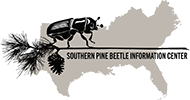Abstract
Two estimators of trends in Dendroctonus frontalis Zimmerman populations are evaluated. One estimator is brood increase ratio, R*, the brood beetles emerging per parent. The other is within-tree survival, S*, the brood beetles emerging per egg. The sampling distributions
of R* and S* were studied using computer simulations. Both R* and S* are biased, always overestimating R and S, but S* is less biased and more consistent than R*. The distributions of R* and S* become less biased and more peaked as sample size increases.
The validity and sensitivity of tests of hypotheses based on R* and S* are discussed. Because the distributions of R* and S* are not normal, the estimators should be used cautiously in tests of hypotheses that assume normality. Besides the statistical problems inherent in using R* and S*, there are problems in gathering sufficient data to calculate the estimators reliably. Complete dissection of bark samples and precise timing of sampling are vital.
